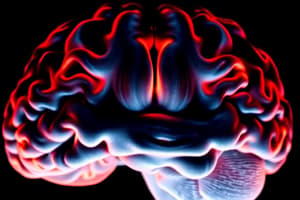Podcast
Questions and Answers
What is a primary focus of neuroeconomics?
What is a primary focus of neuroeconomics?
- Exploring how the brain evaluates risks and rewards (correct)
- Investigating emotional disorders through therapy
- Analyzing genetic influences on cognitive development
- Studying the physiological effects of exercise on the brain
Which of these is NOT a benefit of brain imaging techniques?
Which of these is NOT a benefit of brain imaging techniques?
- Enhanced diagnostic accuracy
- Cost-effective for all patients (correct)
- Non-invasive methods available
- Detailed visualization of brain structures
Which of the following represents a limitation of brain imaging techniques?
Which of the following represents a limitation of brain imaging techniques?
- They are primarily used for non-invasive surgery.
- Interpretation of brain images demands specialized training. (correct)
- They provide a high-resolution view of brain mechanisms.
- Most techniques are completely accessible and affordable.
What emerging technology is expected to enhance brain imaging capabilities?
What emerging technology is expected to enhance brain imaging capabilities?
What ethical consideration is becoming increasingly important in brain imaging research?
What ethical consideration is becoming increasingly important in brain imaging research?
What is the primary purpose of structural imaging techniques in brain imaging?
What is the primary purpose of structural imaging techniques in brain imaging?
Which brain imaging technique is specifically useful for diagnosing epilepsy?
Which brain imaging technique is specifically useful for diagnosing epilepsy?
How does Positron Emission Tomography (PET) highlight areas of brain activity?
How does Positron Emission Tomography (PET) highlight areas of brain activity?
What advantage does Magnetoencephalography (MEG) offer in brain imaging?
What advantage does Magnetoencephalography (MEG) offer in brain imaging?
Which structural imaging technique is best for detecting hemorrhages and fractures?
Which structural imaging technique is best for detecting hemorrhages and fractures?
Which brain imaging technique is particularly effective for assessing brain function during cognitive tasks in infants?
Which brain imaging technique is particularly effective for assessing brain function during cognitive tasks in infants?
What is a major application of brain imaging in medical diagnosis?
What is a major application of brain imaging in medical diagnosis?
What type of imaging method is used to create cross-sectional images of the brain?
What type of imaging method is used to create cross-sectional images of the brain?
Flashcards
Brain Imaging
Brain Imaging
Techniques used to visualize brain structure and function, providing insights into diseases, health, and cognitive processes.
Structural Imaging
Structural Imaging
Focusing on the brain's anatomy, identifying issues like tumors or injuries.
Functional Imaging
Functional Imaging
Measuring brain activity, useful in understanding cognitive functions and processes.
Computed Tomography (CT)
Computed Tomography (CT)
Signup and view all the flashcards
Magnetic Resonance Imaging (MRI)
Magnetic Resonance Imaging (MRI)
Signup and view all the flashcards
Functional Magnetic Resonance Imaging (fMRI)
Functional Magnetic Resonance Imaging (fMRI)
Signup and view all the flashcards
Positron Emission Tomography (PET)
Positron Emission Tomography (PET)
Signup and view all the flashcards
Electroencephalography (EEG)
Electroencephalography (EEG)
Signup and view all the flashcards
Brain Imaging Techniques in Research
Brain Imaging Techniques in Research
Signup and view all the flashcards
Neuroeconomics
Neuroeconomics
Signup and view all the flashcards
Benefits of Brain Imaging
Benefits of Brain Imaging
Signup and view all the flashcards
Limitations of Brain Imaging
Limitations of Brain Imaging
Signup and view all the flashcards
Ethical Considerations in Brain Imaging
Ethical Considerations in Brain Imaging
Signup and view all the flashcards
Study Notes
Brain Imaging Techniques Overview
- Brain imaging is crucial in neuroscience, visualizing brain structure and function.
- It aids in disease diagnosis, assessing brain health, and understanding cognitive functions.
- Procedures are generally non-invasive and offer insights into brain activity/anatomy.
Structural Imaging
- Focuses on brain anatomy to detect large-scale intracranial issues (e.g., tumors, injuries).
- Computed Tomography (CT): Uses X-rays for cross-sectional brain images, useful in identifying hemorrhages and fractures.
- Magnetic Resonance Imaging (MRI): Employs magnetic fields & radio waves for detailed brain structure images, differentiating tissue types.
Functional Imaging
- Measures brain activity, often used in cognitive neuroscience and neuropsychology.
- Functional Magnetic Resonance Imaging (fMRI): Detects blood flow changes to indicate brain activity, showing how different brain areas operate during tasks.
- Positron Emission Tomography (PET): Uses a radioactive tracer to visualize metabolic processes, highlighting highly active brain areas.
Specific Brain Imaging Techniques
- Electroencephalography (EEG): Measures electrical brain activity via scalp electrodes. Effective for epilepsy and sleep disorders.
- Magnetoencephalography (MEG): Records magnetic fields from neuronal activity, precisely localizing brain function (esp. sensory & motor regions).
- Near-Infrared Spectroscopy (NIRS): Monitors brain oxygenation (hemoglobin levels) using infrared light. Non-invasive, useful for infants and cognitive tasks.
Applications of Brain Imaging
- Medical Diagnosis: Essential for diagnosing neurological disorders (e.g., strokes, tumors, multiple sclerosis). Helps in treatment planning & monitoring.
- Research & Cognitive Neuroscience: Studies decision-making, emotions, and cognitive development. Provides insights into brain region interactions & behavior.
- Neuroeconomics: Combines neuroscience with economics to study decision-making processes. fMRI, EEG used to examine brain's risk/reward evaluation.
Advantages and Limitations
- Benefits: Non-invasive procedures, detailed visualizations, improved disorder diagnosis/treatment.
- Limitations: Cost/accessibility concerns, image interpretation complexity, temporal resolution limitations (some techniques).
Future Directions
- Technological Advancements: Emerging technologies (e.g., TMS, advanced MRI) improve brain imaging capabilities, enhancing understanding of connectivity & neuroplasticity.
- Ethical Considerations: Increasing use of brain imaging requires ethical discussions/considerations around privacy, data security, and interpretation of results.
Studying That Suits You
Use AI to generate personalized quizzes and flashcards to suit your learning preferences.





